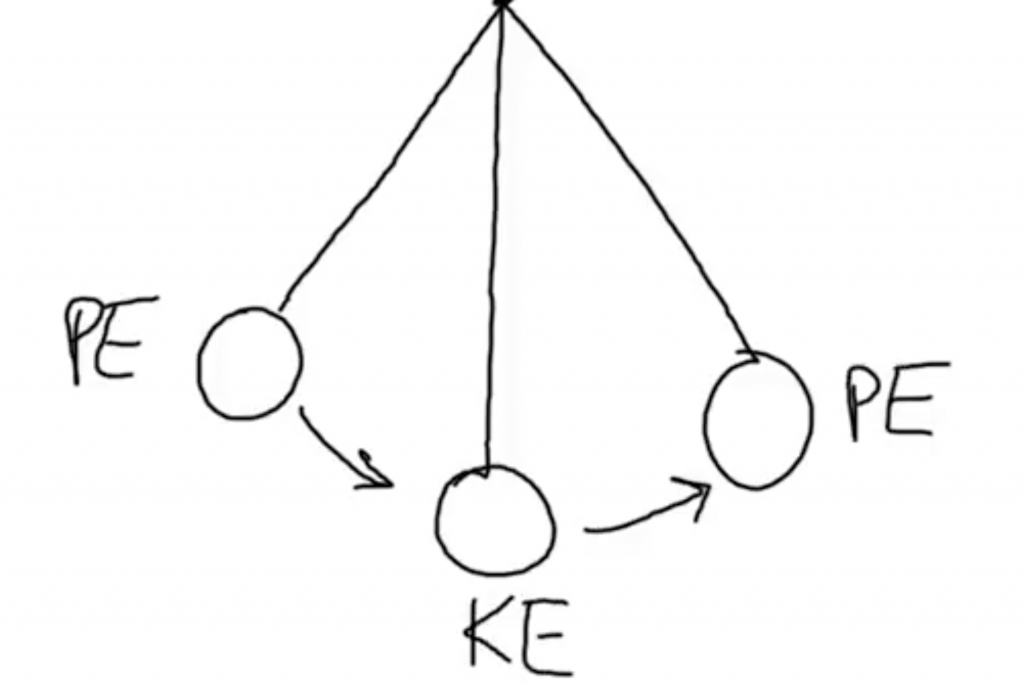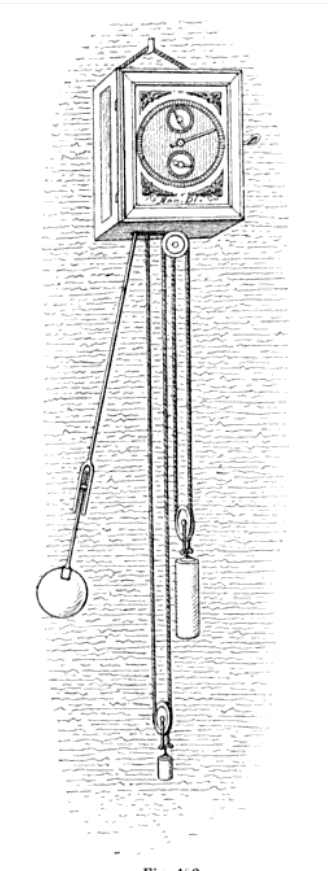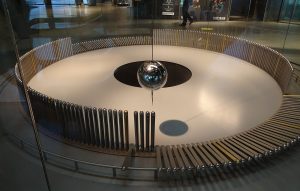10 Pendulums and the Energy Lens on Motion
Formative Assessment
What is a Pendulum?
A pendulum is a weight suspended from a fixed point that can swing freely. Pendulums swing back and forth in a regular motion.
What are some pendulums in real life?
- Swings
- Wrecking ball
- Grandfather clocks
A period is the time it takes a pendulum to swing across and back to its original starting point. One period is shown in the video, below.
Video credit: “2D Animation-Pendulum” by Melissa Gableman is licensed under CC BY-NC-SA 3.0
Why does a pendulum continue to swing for some time after you let it go? It all has to do with it’s energy.
As seen in the image, below, a pendulum has potential energy (PE) and kinetic energy (KE):

- At the starting point of its swing, the pendulum has potential energy.
- As the pendulum swings downward, its potential energy is converted into kinetic energy.
- As the pendulum swings upward, its kinetic energy is converted back into potential energy.
- Newton’s First Law says that objects in motion tend to stay in motion, and objects at rest tend to stay at rest, unless acted upon by an outside force. Therefore, this energy conversion will allow the pendulum to continue swinging back and forth. Eventually, its energy will be lost to forces like friction and the pendulum will come to a stop.
For more explanation of potential and kinetic energy, watch the first few minutes of the video, below.
Video credit: “Potential and Kinetic Energy” by Bozeman Science is licensed under CC BY 3.0
If a wrecking ball was knocking down a building, where in its swing would you want the ball to connect to the building? Where in its swing does it have the most destructive power? Why?
Wrecking ball in action by Stefan Kühn is licensed under CC BY-SA 3.0
Watch the video below to see a wrecking ball in action.
The wrecking ball connects to the building at the bottom of its swing.
The video, below, shows 15 pendulums swinging from the same bar. Although the pendulums are released at the same time, they swing at different speeds. This creates the visual effect of a wave. If you focus on one pendulum at a time, you can see that each pendulum is in fact swinging back and forth in a consistent motion.
Video credit: “Pendulum Waves” by Harvard Natural Sciences Lecture Demonstrations is used with permission
In lab, we modeled a playground swing by creating a simple pendulum from a string with a weight attached at the end. As a class, we asked: How does the period of a pendulum depend upon weight, the angle of release, and/or the length of the string?
You can repeat the lab with this online PhET simulation here.
We found that:
- Weight does not affect the period
- The angle of release does not affect the period for small angles (about 20° or less), but for larger angles, larger angles of release means a longer period
- A longer pendulum has a longer period
Watch the pendulum waves video, above, again and notice each variable.
- Each pendulum’s weight has the same mass.
- Each pendulum is released at the same angle.
- Each pendulum has a different length of string which causes them to swing at different speeds. Focus on the shortest pendulum and you can see that it swings fastest. Focus on the longest pendulum and you can see that it swings slowest.
Key Takeaway
The speed of a pendulum’s swing is affected by the length of the string.
- Longer string=slower swing, fewer periods in 10 seconds
- Shorter string=faster swing, more periods in 10 seconds
Why are pendulums important in science?
Galileo and Clocks
In the early 1600s, Galileo noticed the swinging motion of a chandelier in the Cathedral of Pisa. By watching the chandelier and timing its swings, Galileo found that each swing of the pendulum took the same amount of time, even as the angle of the swings changed (note that the normal swings of a chandelier are much less than 20°!).

In 1657, Christiaan Huygens, a Dutch scientist, used Galileo’s discoveries to patent the first pendulum clock. Before this, clocks were only accurate within a range of 15 minutes, but Huygens’ pendulum clock was accurate within 15 seconds.

Focault’s Pendulum
In 1851, a Frenchman named Léon Focault used a pendulum to demonstrate that Earth rotated on its axis, a disputed scientific fact at the time. To do this, a Focault pendulum has a heavy metal weight suspended from a high ceiling. It is surrounded by a circle of pins which are knocked down by the pendulum’s swings. Over time, the pendulum’s path swing changes due to the influence of Earth’s rotation and pins fall all around the circle.
As seen in the image, below, Focault pendulums are a familiar sight in science museums around the world today.

Pendulums in Real Life
Wrecking ball
As seen in the image, below, a wrecking ball is a large pendulum suspended from a construction crane.

Tire swing vs. playground swing
Swings are an easy way to see pendulums in real life.
- In the image on the left, a tire swing is an example of a simple pendulum.
- In the image on the right, the playground swings are suspended from two chains. As shown in the pendulum lab, the length of a pendulum’s string affects the amount of time each period takes. Therefore, both chains on the swing must be exactly the same length or the two sides of the swing will move at different speeds in a jerky motion.


NGSS Standards
Performance Expectations
| 3-PS2-2. | Make observations and/or measurements of an object’s motion to provide evidence that a pattern can be used to predict future motion. |
|---|
| MS-PS3-1. | Construct and interpret graphical displays of data to describe the relationships of kinetic energy to the mass of an object and to the speed of an object. |
|---|
| MS-PS3-2. | Develop a model to describe that when the arrangement of objects interacting at a distance changes, different amounts of potential energy are stored in the system. |
|---|
Disciplinary Core Ideas
Third grade:
PS2.A: Forces and Motion
- The patterns of an object’s motion in various situations can be observed and measured; when that past motion exhibits a regular pattern, future motion can be predicted from it
Middle School:
PS3.A: Definitions of Energy
- Motion energy is properly called kinetic energy; it is proportional to the mass of the moving object and grows with the square of its speed. (MS-PS3-1)
- A system of objects may also contain stored (potential) energy, depending on their relative positions. (MS-PS3-2)
PS3.B: Conservation of Energy and Energy Transfer
Crosscutting Concepts
Scale, Proportion, and Quantity
- Proportional relationships (e.g. speed as the ratio of distance traveled to time taken) among different types of quantities provide information about the magnitude of properties and processes. (MS-PS3-1),(MS-PS3-4)
Systems and System Models
- Models can be used to represent systems and their interactions – such as inputs, processes, and outputs – and energy and matter flows within systems. (MS-PS3-2)
- Energy may take different forms (e.g. energy in fields, thermal energy, energy of motion). (MS-PS3-5)
- The transfer of energy can be tracked as energy flows through a designed or natural system. (MS-PS3-3)
Lesson Ideas:
Build a block wall. Can the children make the pendulum smash the wall down?
Have children experiment with mass, length of string, how high they raise the pendulum, etc to see what variables affect period. You can have them set up two pendulums at a time to compare the period.
On the playground, have the children experiment with swings. How do you make an empty swing go higher? Faster? How about with a friend?
The energy held by an object that gives it capacity to do work.
The energy of an object due to motion.
The time it takes a pendulum to swing across and back to its original starting point.

